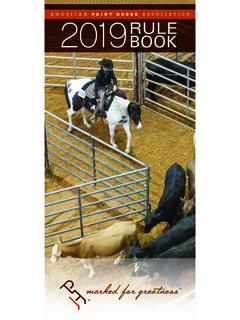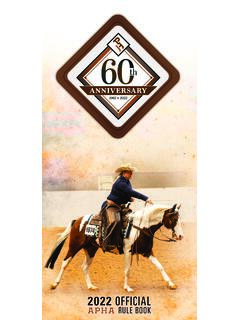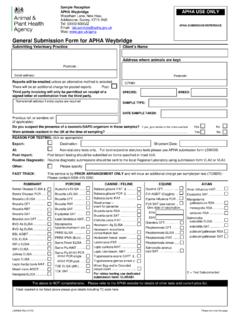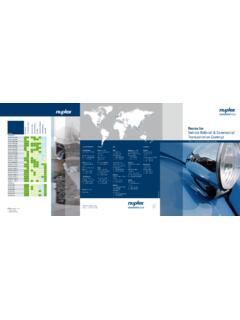Transcription of 07CoatColorGenetics 12/14/07 6:51 PM Page A - APHA
1 07 CoatColorGenetics 12/14/07 6:51 PM Page AContentsThe Genetic Equation of Paint Horses ..IFCT obiano ..1 Overo ..1 Tovero ..3 Breeding the Tobiano Paint ..4 Genes ..4 Understanding Simple Dominance ..4 Using the Punnett Square ..4 Understanding genes, simple dominance and the Punnett Square ..4 Breeding the Tobiano Paint ..5 Determining Tobiano Homozygosity ..5 Breeding the Overo Paint ..6 Breeding the Frame Overo ..6 Defining Minimal-White Frame Overo ..6 Breeding the Splashed White Overo ..6 Defining Minimal Splashed-White Overo ..6 Breeding the Sabino Overo ..7 Defining Minimal-White Sabino Overo ..7 Breeding the Tovero ..7 Coat Colors ..8 The Basic Rules of Coat Color Genetics.
2 9 Overo Lethal White Syndrome ..16 Lethal Whites Fact Versus Fiction ..16 References ..17 Color Description Guide ..BCFor more information on the American Paint Horse Association and what it can offer you, call (817) 834-2742, extension APHA s official Web site at Genetic Equation of Paint HorsesPaint Horses are unique from most other breedsbecause of their spotted coat patterns. Their base coatsare the same colors as those of other breeds, but super-imposed over these colors are a variety of white spottingpatterns. The three patterns recognized by APHA aretobiano, overo and ability to recognize these patterns and under-stand the genetics behind them is essential for PaintHorse breeders. Being knowledgeable about coat pat-terns helps breeders and owners accurately describetheir horses.
3 Understanding the genetics that producethese patterns helps breeders increase the proportion ofspotted horses in their foal are descriptions of the major Paint Horsespotting 12/14/07 6:51 PM Page BThe second generally accepted type ofspotting is overo (pronounced: oh vair oh).Knowing the history behind the term overomay be helpful in understanding the some-what confusing situation of having multiplepatterns with one is a Spanish word, originally mean-ing like an egg. In this case, it refers tospeckling or spotting. Long ago, in SouthAmerica, the term overo was used for all thevarious spotting patterns in horses: tobiano,overo (all three types) and also the blanketand leopard patterns typical of Argentina, the word overo is still used todescribe all the different spotting patternsother than the United States, overo is usually usedto mean Paint, but not tobiano.
4 This hasresulted in the lumping together of threedifferent spotting patterns under one name,and the result can be confusion in term overo covers three geneticallydistinct patterns: frame overo, sabino andsplashed OveroThe name frame refers to the usualappearance, which is of white patches cen-tered in the body and neck, and framed bycolored areas around usual frame pattern has a horizontalarrangement and does not cross the topline,as does tobiano. The overo s head is usuallyquite extensively marked with white and theeyes are commonly feet and legs of frame overos are usu-ally dark, although white feet and minorThe first major pattern is tobiano (pro-nounced: tow be yah no). The name tobianois itself unusual and has an interesting history.
5 In Argentina, it is the habit to nameunusual colors after horses or people whoconnect the color to a specific event or indi-vidual. In the case of the tobiano horse, thatevent was the rescue of Buenos Aires byBrazilian General Tobias during a militaryaction that took place in the 1800s. Many ofthe troops with Tobias were mounted ontobiano spotted horses from color pattern had occurred only rarelyin Argentina before this event (and waslumped in with all the other spotting patternsas overo), but became firmly associated withTobias and his troops afterwards, ending uptaking his distinctive tobiano pattern occurs in manybreeds worldwide. It is common in ponybreeds, some draft breeds and evenoccurs in some of the warmblood some breeds, tobiano spotting disquali-fies a horse for inclusion in the registry this in spite of the fact that the trait mayhave been present in some of the founda-tion horses from which the breed characteristics of tobianoA tobiano s feet and varying portions ofits legs are usually white, the head usuallyhas no more white than normally found ona non-spotted horse, and the spots usual-ly cross the topline somewhere betweenthe ears and spots are typically crisply delineat-ed from the colored areas and have a vertical arrangement.
6 A tobiano s eyes are usually horses can vary from quite dark, with only small amounts of white, to quite white, with littleremaining color. The darker individuals some-times have so little white spotting that theymay be confused with nonspotted spotted tobianos are interest-ing because they are essentially tobianosthat did not get spots. These horses willproduce just like a spotted horse, however,and that is the reason the pattern may mysteriously appear in a breeding pro-gram for solid clue to identifying these nonspottedtobianos is that they tend to have a largeamount of white on the lower legs but littlewhite on the head. This combination is oth-erwise rare because it is usually the casethat non-spotted horses with a great dealof white on the head have a large amountof white on the feet, and vice the middle portion of the range oftobiano spotting there is no problem tellingtobianos from other Paint patterns.
7 They arequite distinctive. At the whitest extreme,many tobianos are all white except for a col-ored head. This pattern is sometimes called Moroccan, although the connection to thecountry of Morocco or its horses is tenuousat details of the tobiano pattern includethe fact that on many of these horses, theborder between the white and colored areasconsists of pigmented skin overlaid by whitehairs. The result is usually a bluish cast tothe border, almost like a halo or a peculiarity of some tobianos is thepresence of ink spots in the white patch-es. These spots are small and generallyround in Coat Color Genetics Guide 1 TobianoOvero Typical Tobiano PatternsTypical Overo PatternsTobiano07 CoatColorGenetics 12/14/07 6:51 PM Page 1white leg marks are as common on frameoveros as they are on nonspotted white areas on frame overos are usual-ly crisply and cleanly delineated from thecolored areas, although some have a halo orshadow of pigmented skin under white hairdirectly at the frame overo pattern occurs in a lim-ited range of horse breeds.
8 It seems toappear only in breeds that have Spanishancestry, including the Paint genetics of frame overo has onlyrecently been documented. Frame overobehaves as a dominant gene. It is commonto mate frame overo horses to nonspottedhorses, and about half of the resulting foalsare many occasions, though, there arerecords of frame overos being produced bytwo nonspotted parents. This is typical of arecessive gene, and it is not logical to haveboth a recessive and a dominant controlover the same pattern. Some of these horses are genetically frameovero, but have failed to get a body spot. Theyare essentially very dark frame overos sodark that the spots are all gone from the still have the gene, however, and can stillproduce frame overo-spotted the whiter extreme, frame overo is thepattern most closely associated with OveroLethal White Syndrome (see page 16).
9 Recent characterization of the generesponsible for lethal white foal syndromehas confirmed that foals with two doses ofthe lethal white gene are white and die soonafter birth from gut innervation abnormali-ties. Horses with only one dose documentation is important forPaint Horse breeders. With DNA tests nowavailable to identify the lethal white gene, itis possible to test breeding horses. Those with the gene can bemated to horses with-out it, resulting infoals that are abouthalf carriers and half-non-carrier foals, but avoiding completelythe production of lethal OveroIn literal Spanish, sabino (pronounced:sah bee no) means pale or speckled. InEurope, and increasingly in the UnitedStates, sabino is used to describe a uniqueand interesting pattern of white spotting horses usually have four white feetand white legs.
10 The white usually extendsup the legs in ragged patches, and thenextends onto the horse s body from the head is usually fairly white and the eyesare commonly sabino horses have partially blue,partially brown eyes. Flecks, patches androan areas are common on sabinos, in con-trast to the frame overos, which are usuallymore crisply occurs in a large num-ber of breeds worldwide,including Paints, Thorough-breds and Clydesdales. The pat-tern is commonly the cause ofspotted foals that appear inbreeds that frown on them, suchas the British pony breeds andthe Quarter sabino pattern is also agreat imitator, and some of thesehorses are nearly perfect mimicsof tobiano or frame overo. Whenthe sabino pattern is minimally expressed, the horse usual-ly has four white socksand a blaze.







